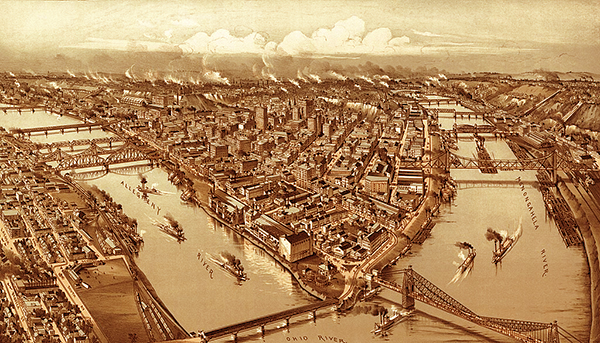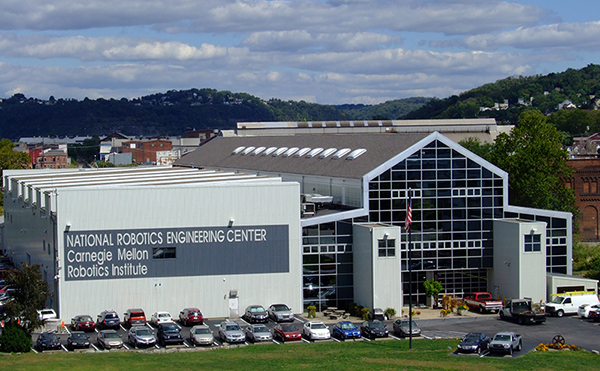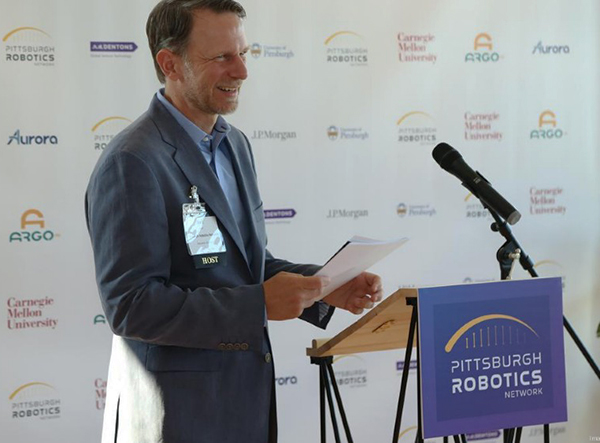In “Pittsburgh: From Dying Steel Town to Global Robotics Hub” Henry Lenard, lifelong Pittsburgh resident and former writer for the Pittsburgh Business Times, shares with our readers how Pittsburgh pulled off this remarkable renaissance.
“At the peak of the Pittsburgh steel industry in the early 1970s, it employed more than 90,000 workers. By 1980, that number dropped to 44,000. In the mid-1980s, the entire industry collapsed, with massive layoffs and mill closures. By 2000, 29 steel companies in Pittsburgh had declared bankruptcy.” —Henry Lenard
by Henry Lenard
When steel baron and philanthropist Andrew Carnegie donated the money in 1900 to open a vo-tech school for the children of working-class Pittsburghers, many of whom toiled in his factories, he had no idea that nearly a century later that investment could be viewed as the seed money that made Pittsburgh a global robotics hub. That transformation, however, was far from a seamless one.

Carnegie’s mills and others made Pittsburgh into an industrial powerhouse, widely regarded as the steel capital of the world for most of the 20th century. Well-known as the ‘Steel City’, the iron and steel industry brought great wealth to Pittsburgh.
The focus on this one sector became exposed as the city’s Achille’s heel following the steel strike of 1959. A 116-day labor stoppage by the United Steelworkers of America idled the steel industry throughout the U.S. While the union ultimately won the strike, it led to the significant importation of cheaper foreign steel for the first time in American history. The subsequent drop in the price of steel was devastating to Pittsburgh.
At the peak of the Pittsburgh steel industry in the early 1970s, it employed more than 90,000 workers. By 1980, that number dropped to 44,000. In the mid-1980s, the entire industry collapsed, with massive layoffs and mill closures. By 2000, 29 steel companies in Pittsburgh had declared bankruptcy.
In 1979, while Pittsburgh was hemorrhaging people and jobs, the city’s Carnegie Mellon University (CMU), whose origins can be traced directly to Carnegie’s Carnegie Technical Schools in 1900, created the first robotics program in the world.

With a $3 million industrial research grant from Westinghouse, CMU’s Robotics Institute was established to create basic and applied research in robotics technologies relevant to industrial and societal tasks. The first AI undergraduate degree program began at the school and CMU’s Robotics Institute became the first in the world to offer a Ph.D. in robotics in 1988.
In an interesting footnote, Westinghouse’s predecessor company, Westinghouse Electric & Manufacturing Co., is considered to have created the world’s first physical robot, the Herbert Televox, in 1927.
Westinghouse designed numerous additional robots in the following years, including the seven-foot Elektro the Moto-Man, who premiered at the 1939 World’s Fair in New York City. In many ways, the early history of Westinghouse and the company’s interest in robots were a forerunner to the contemporary robotic research conducted at CMU.
Pittsburgh Mayor Bill Peduto has been quoted as saying that during the 1980s and early 1990s, when every politician was saying how they were going to bring the mills back, there were people in Pittsburgh who were building out an entirely new economy based upon technology and education. “It was not an overnight success, it was 30 years of work,” said Peduto.
Even when robotics technologies were relatively primitive, CMU saw their potential role in boosting the productivity and competitiveness of the U.S. in the evolving global marketplace.
CMU’s Robotics Institute diversified its efforts and approaches to robotics science while retaining its original goal of realizing the potential of the robotics field. It is now the world’s largest R&D organization. The institute includes approximately 100,000 square feet at its Pittsburgh campus and another 100,000 square feet at the nearby National Robotics Engineering Center (NREC), which opened in 1996.
NREC works closely with government and industry clients to apply robotic technologies to real-world processes and products, including unmanned vehicle and platform design, autonomy, sensing and image processing, machine learning, manipulation, and human–robot interaction.
In 2007, CMU roboticist and research professor Red Whittaker won the DARPA Grand Challenge/Urban Challenge for American autonomous vehicles, and its $2 million prize. The challenge, funded by the U.S. Department of Defense’s Defense Advanced Research Projects Agency, was designed to spur development of self-driving vehicles.
The Urban Challenge involved a 96-km (60-mile) urban area course to be completed less than six hours. Rules included obeying all traffic regulations while negotiating with other traffic and obstacles and merging into traffic. Designers had to build a vehicle that would obey all traffic laws while detecting and avoiding other robots on the course.
CMU’s win put Pittsburgh on the map as the birthplace of self-driving car development, which dates to the university’s research in the 1980s.
In 2014, Pittsburgh became the first city in the country to enter a memorandum of understanding with a university. The agreement with CMU allows the city to utilize the university as its R&D department while allowing the school to use the city as its urban lab, enabling it to test products before taking them to market.
See related: Daegu City (Korea). Asia’s Next Robot Technopolis
The Fall & Rise of Pittsburgh
(from podcast Episode #26):
Excerpt 9:16
That agreement brought Uber to Pittsburgh as it was looking for a partner willing to serve as an urban R&D lab. Last December, Silicon Valley startup Aurora acquired Uber’s Advanced Technology Group. This past September, Aurora made Pittsburgh its headquarters.
Along with pedestrian traffic, Pittsburgh terrain and infrastructure is a major attraction for autonomous vehicle developers. The origins of many of the city’s narrow and hilly streets date to pre-Revolutionary War forest trails. Plus, there are also the city’s more than 400 bridges that create their own navigational challenges. Throw in four seasons of changing weather and Pittsburgh offers an array of driving conditions hard to find elsewhere.
More importantly, CMU’s robotics department offers a rich talent pool.
Also headquartered in Pittsburgh is Argo AI, an autonomous driving technology company founded in 2016 by veterans of the Google and Uber automated driving programs. Argo has two major investors: Ford Motor Co. and the Volkswagen Group. Argo’s Self Driving System technology will be incorporated into vehicles manufactured by the automakers through these partnerships. The autonomous vehicle technology company has grown its team to more than 500 in Pittsburgh and 1,300 worldwide.
Pittsburgh’s century-and-half history of being a center for manufacturing has also benefited its evolution into a robotics hub. The many shuttered steel mills and factories providing ready-made space for turnkey robotics ventures.
In addition, the existing infrastructure of suppliers and machine shops that supported the steel industry are eager to assist the new robotics startups.
“These old-school companies are looking to keep their pipelines busy,” 412 Venture Fund Managing Partner Ilana Diamond said. “They’re thrilled to death to see all these new companies begin here and are more than willing to partner with these startups.”
Since 2012, $3.4 billion in venture capital and private equity has been invested in Pittsburgh’s robotics firms, and nearly 600 patents have been awarded for robotics-based innovation.
In the past five years, the technology talent pool in Pittsburgh has grown by 20 percent, with over 45,000 workers in the industry. And in Pittsburgh’s robotics sector, employment has grown by 300 percent since 2011, to more than 7,000 workers.
Dozens if not hundreds of robotics companies have spun out of CMU’s Robotics Institute. But Pittsburgh robotics has grown beyond its CMU roots.
More than a dozen organizations support the Pittsburgh robotics ecosystem, led by the Pittsburgh Robotics Network. The PRN was formed by robotics leaders in 2018 to build a connected community and leverage shared resources. In 2020, the PRN expanded its mission to enhance Pittsburgh’s standing in the worldwide robotics community and advance robotics and artificial intelligence technologies globally.

The PRN represents the companies and leaders who make up the Pittsburgh robotics ecosystem, which is anchored by CMU and driven by more than 100 robotics organizations, now including the University of Pittsburgh. Pitt’s Swanson School of Engineering and School of Computing Information produces top engineers and scientific research.
“The research and innovation community at the University of Pittsburgh is excited to collaborate and learn from other members of the PRN,” Rob Rutenbar, Pitt’s senior vice chancellor for research, said. “With our world-class engineering, computer science and information science capabilities, and our region’s reputation as a global leader in the industry, this alliance will help us continue to drive innovation in robotics and build the economy of the future.”
Pittsburgh’s position as one of the top robotics research hubs in the U.S. has set it up to be a world leader in this industry. Pittsburgh is near the head of the pack, trailing only Boston but ahead of Silicon Valley and other robotics hotbeds such as Tokyo and Seoul, according to Gizmodo.
“Pittsburgh is a bigger, more capable and more influential robotics center than the world knows,” said PRN Executive Director Joel Reed.
 Pittsburgh native Henry Lenard has had a front row seat to the city’s economic transformation. He is the former editor of the Pittsburgh Business Times and was the Pittsburgh reporter for Robotics Business Review.
Pittsburgh native Henry Lenard has had a front row seat to the city’s economic transformation. He is the former editor of the Pittsburgh Business Times and was the Pittsburgh reporter for Robotics Business Review.
See related: The Pittsburgh Story, Part 2
Flexing Pittsburgh’s Robotics Prowess
Positioned to help meet America’s greatest manufacturing challenges


